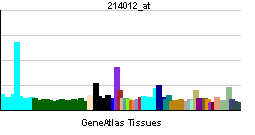ARTS-1
| Type 1 tumor necrosis factor receptor shedding aminopeptidase regulator | |||
|---|---|---|---|
| Identifiers | |||
| Symbols | ARTS-1 ; A-LAP; ALAP; APPILS; ARTS1; ERAAP; ERAP1; KIAA0525; PILSAP | ||
| External IDs | Template:OMIM5 Template:MGI HomoloGene: 56754 | ||
| RNA expression pattern | |||
 | |||
 | |||
| More reference expression data | |||
| Orthologs | |||
| Template:GNF Ortholog box | |||
| Species | Human | Mouse | |
| Entrez | n/a | n/a | |
| Ensembl | n/a | n/a | |
| UniProt | n/a | n/a | |
| RefSeq (mRNA) | n/a | n/a | |
| RefSeq (protein) | n/a | n/a | |
| Location (UCSC) | n/a | n/a | |
| PubMed search | n/a | n/a | |
Type 1 tumor necrosis factor receptor shedding aminopeptidase regulator, also known as ARTS-1, is a human gene.[1]
Aminopeptidases play a role in the metabolism of several peptides that may be involved in blood pressure and the pathogenesis of essential hypertension (MIM 145500). Adipocyte-derived leucine aminopeptidase (ALAP) is a member of the M1 family of zinc metallopeptidases.[supplied by OMIM][1]
References
Further reading
- Nakajima D, Okazaki N, Yamakawa H; et al. (2003). "Construction of expression-ready cDNA clones for KIAA genes: manual curation of 330 KIAA cDNA clones". DNA Res. 9 (3): 99–106. PMID 12168954.
- Tsujimoto M, Hattori A (2005). "The oxytocinase subfamily of M1 aminopeptidases". Biochim. Biophys. Acta. 1751 (1): 9–18. doi:10.1016/j.bbapap.2004.09.011. PMID 16054015.
- Maruyama K, Sugano S (1994). "Oligo-capping: a simple method to replace the cap structure of eukaryotic mRNAs with oligoribonucleotides". Gene. 138 (1–2): 171–4. PMID 8125298.
- Suzuki Y, Yoshitomo-Nakagawa K, Maruyama K; et al. (1997). "Construction and characterization of a full length-enriched and a 5'-end-enriched cDNA library". Gene. 200 (1–2): 149–56. PMID 9373149.
- Nagase T, Ishikawa K, Miyajima N; et al. (1998). "Prediction of the coding sequences of unidentified human genes. IX. The complete sequences of 100 new cDNA clones from brain which can code for large proteins in vitro". DNA Res. 5 (1): 31–9. PMID 9628581.
- Hattori A, Matsumoto H, Mizutani S, Tsujimoto M (1999). "Molecular cloning of adipocyte-derived leucine aminopeptidase highly related to placental leucine aminopeptidase/oxytocinase". J. Biochem. 125 (5): 931–8. PMID 10220586.
- Hattori A, Kitatani K, Matsumoto H; et al. (2001). "Characterization of recombinant human adipocyte-derived leucine aminopeptidase expressed in Chinese hamster ovary cells". J. Biochem. 128 (5): 755–62. PMID 11056387.
- Hattori A, Matsumoto K, Mizutani S, Tsujimoto M (2001). "Genomic organization of the human adipocyte-derived leucine aminopeptidase gene and its relationship to the placental leucine aminopeptidase/oxytocinase gene". J. Biochem. 130 (2): 235–41. PMID 11481040.
- Yamamoto N, Nakayama J, Yamakawa-Kobayashi K; et al. (2002). "Identification of 33 polymorphisms in the adipocyte-derived leucine aminopeptidase (ALAP) gene and possible association with hypertension". Hum. Mutat. 19 (3): 251–7. doi:10.1002/humu.10047. PMID 11857741.
- Cui X, Hawari F, Alsaaty S; et al. (2002). "Identification of ARTS-1 as a novel TNFR1-binding protein that promotes TNFR1 ectodomain shedding". J. Clin. Invest. 110 (4): 515–26. PMID 12189246.
- Serwold T, Gonzalez F, Kim J; et al. (2002). "ERAAP customizes peptides for MHC class I molecules in the endoplasmic reticulum". Nature. 419 (6906): 480–3. doi:10.1038/nature01074. PMID 12368856.
- Saric T, Chang SC, Hattori A; et al. (2002). "An IFN-gamma-induced aminopeptidase in the ER, ERAP1, trims precursors to MHC class I-presented peptides". Nat. Immunol. 3 (12): 1169–76. doi:10.1038/ni859. PMID 12436109.
- York IA, Chang SC, Saric T; et al. (2002). "The ER aminopeptidase ERAP1 enhances or limits antigen presentation by trimming epitopes to 8-9 residues". Nat. Immunol. 3 (12): 1177–84. doi:10.1038/ni860. PMID 12436110.
- Strausberg RL, Feingold EA, Grouse LH; et al. (2003). "Generation and initial analysis of more than 15,000 full-length human and mouse cDNA sequences". Proc. Natl. Acad. Sci. U.S.A. 99 (26): 16899–903. doi:10.1073/pnas.242603899. PMID 12477932.
- Cui X, Rouhani FN, Hawari F, Levine SJ (2003). "An aminopeptidase, ARTS-1, is required for interleukin-6 receptor shedding". J. Biol. Chem. 278 (31): 28677–85. doi:10.1074/jbc.M300456200. PMID 12748171.
- Clark HF, Gurney AL, Abaya E; et al. (2003). "The secreted protein discovery initiative (SPDI), a large-scale effort to identify novel human secreted and transmembrane proteins: a bioinformatics assessment". Genome Res. 13 (10): 2265–70. doi:10.1101/gr.1293003. PMID 12975309.
- Cui X, Rouhani FN, Hawari F, Levine SJ (2004). "Shedding of the type II IL-1 decoy receptor requires a multifunctional aminopeptidase, aminopeptidase regulator of TNF receptor type 1 shedding". J. Immunol. 171 (12): 6814–9. PMID 14662887.
- Shibata D, Ando H, Iwase A; et al. (2004). "Distribution of adipocyte-derived leucine aminopeptidase (A-LAP)/ER-aminopeptidase (ERAP)-1 in human uterine endometrium". J. Histochem. Cytochem. 52 (9): 1169–75. doi:10.1369/jhc.3A6216.2004. PMID 15314084.
- Gerhard DS, Wagner L, Feingold EA; et al. (2004). "The status, quality, and expansion of the NIH full-length cDNA project: the Mammalian Gene Collection (MGC)". Genome Res. 14 (10B): 2121–7. doi:10.1101/gr.2596504. PMID 15489334.
| This protein-related article is a stub. You can help Wikipedia by expanding it. |